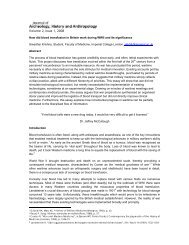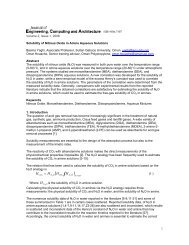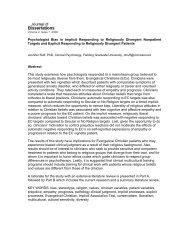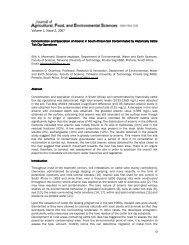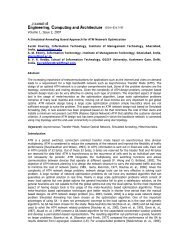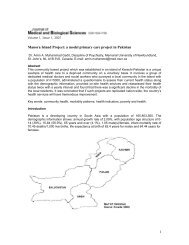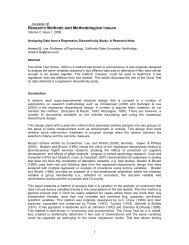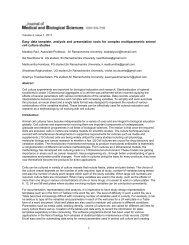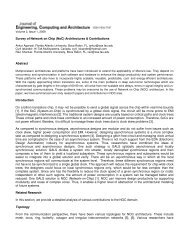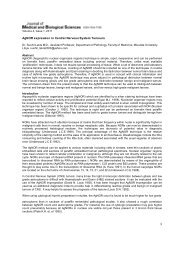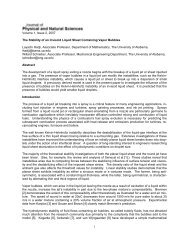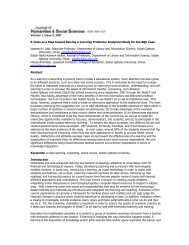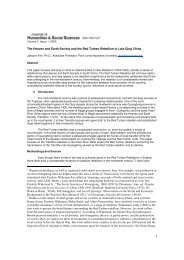Early Journalists and the Evolution of Publicists - Scientific Journals ...
Early Journalists and the Evolution of Publicists - Scientific Journals ...
Early Journalists and the Evolution of Publicists - Scientific Journals ...
You also want an ePaper? Increase the reach of your titles
YUMPU automatically turns print PDFs into web optimized ePapers that Google loves.
Volume 2, Issue 1 2008<br />
<strong>Early</strong> <strong>Journalists</strong> <strong>and</strong> <strong>the</strong> <strong>Evolution</strong> <strong>of</strong> <strong>Publicists</strong>’ Stunts: From Circus Ballyhoo to Pr<strong>of</strong>essionalism<br />
Denise E. DeLorme, Associate Pr<strong>of</strong>essor, University <strong>of</strong> Central Florida, ddelorme@mail.ucf.edu<br />
Fred Fedler, Pr<strong>of</strong>essor, University <strong>of</strong> Central Florida, ffedler@pegasus.cc.ucf.edu<br />
Abstract<br />
This study examines early journalists <strong>and</strong> public relations publicity practices through an historical analysis<br />
<strong>of</strong> 150 autobiographies, 100 biographies, <strong>and</strong> 250 magazine articles written by <strong>and</strong> about newspaper<br />
reporters <strong>and</strong> editors in <strong>the</strong> United States from about 1800-1940. The results trace seven factors<br />
associated with <strong>the</strong> emergence <strong>and</strong> evolution <strong>of</strong> publicists’ stunts from <strong>the</strong> perspective <strong>of</strong> early US<br />
journalists. The findings provide insight into <strong>the</strong> development <strong>of</strong> pr<strong>of</strong>essionalism in <strong>the</strong> public relations<br />
field, enhance underst<strong>and</strong>ing <strong>of</strong> <strong>the</strong> complex journalist-PR practitioner relationship, <strong>and</strong> <strong>of</strong>fer a foundation<br />
for future inquiry.<br />
Introduction<br />
Institutions want favorable <strong>and</strong> free publicity: businesses, churches, <strong>the</strong> military, <strong>and</strong> zoos, for example.<br />
Graber, McQuail <strong>and</strong> Norris explain that politicians, too, want to influence <strong>the</strong> media’s choice <strong>of</strong> stories<br />
<strong>and</strong> to control <strong>the</strong> way in which <strong>the</strong> media frame particular stories. 1 To obtain more free <strong>and</strong> favorable<br />
publicity, institutions create clever stunts, which are “pseudo events” designed solely to generate media<br />
attention. 2 Today’s military created dubious heroes (Jessica Lynch <strong>and</strong> Pat Tillman) <strong>and</strong> showed Iraqis,<br />
apparently spontaneously, toppling a statue <strong>of</strong> Saddam Hussein. Presidential c<strong>and</strong>idates speak in flag<br />
factories, ride in tanks, <strong>and</strong> eat lunch on <strong>the</strong> front porches <strong>of</strong> Iowa farmhouses. Sitting presidents act<br />
presidential, touring disaster areas <strong>and</strong> traveling abroad. Zoos with newborns ask <strong>the</strong> public to name<br />
<strong>the</strong>m. All <strong>the</strong> “events” are carefully contrived to attract <strong>the</strong> media <strong>and</strong> influence public opinion. It is a 200year-old<br />
problem <strong>and</strong> an issue especially relevant this year, <strong>the</strong> year <strong>of</strong> a presidential election.<br />
The relationship between journalists <strong>and</strong> public relations practitioners is riddled with contradictions, many<br />
100 to 200 years old. <strong>Journalists</strong> seem skeptical, even contemptuous, <strong>of</strong> PR (public relations)<br />
practitioners. Yet increasingly, <strong>the</strong>y depend upon PR practitioners for much <strong>of</strong> <strong>the</strong> news. For years,<br />
journalists supplemented <strong>the</strong>ir incomes by working part-time in PR. Today, half <strong>of</strong> <strong>the</strong> men <strong>and</strong> women<br />
who leave <strong>the</strong> newspaper industry obtain full-time jobs in public relations. 3<br />
As <strong>the</strong> field <strong>of</strong> public relations evolved, its first practitioners used techniques that when judged by today’s<br />
st<strong>and</strong>ards seem crude <strong>and</strong> unpr<strong>of</strong>essional. The purpose <strong>of</strong> this article is to explore <strong>the</strong> evolution <strong>of</strong> those<br />
techniques, especially publicity stunts, from <strong>the</strong> point <strong>of</strong> view <strong>of</strong> early US journalists. The topic deserves<br />
investigation because it may help to explain journalists’ lingering hostility toward public relations. Once<br />
established, negative attitudes were passed from one generation <strong>of</strong> journalists to <strong>the</strong> next <strong>and</strong> became so<br />
deeply ingrained that <strong>the</strong>y are difficult to change. While examining <strong>the</strong> evolution <strong>of</strong> publicity stunts, this<br />
paper also traces PR practitioners’ gradual shift toward more pr<strong>of</strong>essionalism. We will begin with a review<br />
<strong>of</strong> <strong>the</strong> relevant literature. Comprehensive historical background on <strong>the</strong> development <strong>of</strong> public relations is<br />
published elsewhere. 4<br />
Review <strong>of</strong> <strong>the</strong> Literature<br />
Three streams <strong>of</strong> research pertinent to <strong>the</strong> present investigation include: research on <strong>the</strong> journalist-PR<br />
practitioner relationship, research on pr<strong>of</strong>essional st<strong>and</strong>ards <strong>and</strong> ethics, <strong>and</strong> research on publicity stunts<br />
<strong>and</strong> hoaxes. Within each <strong>of</strong> <strong>the</strong>se streams, <strong>the</strong> most relevant identified work will be summarized.<br />
1
Research on <strong>the</strong> Journalist-PR Practitioner Relationship<br />
Interaction between journalists <strong>and</strong> public relations practitioners is necessary but complicated. Research<br />
has revealed longst<strong>and</strong>ing tension in <strong>the</strong> relationship, with journalists in particular maintaining negative<br />
attitudes toward PR practitioners. A study by Lucarelli provides some background information into<br />
journalists’ hostility toward public relations practitioners. After World War I, <strong>the</strong>re was a shortage <strong>of</strong><br />
newsprint <strong>and</strong> <strong>the</strong> dem<strong>and</strong> for advertising was breaking records. Earlier, newspapers promoted<br />
advertisers by publishing favorable news stories (i.e., puffery) along with <strong>the</strong>ir advertisements.<br />
The industry’s trade journals advised newspaper editors <strong>and</strong> publishers that <strong>the</strong>y could save space by<br />
discarding press agents’ h<strong>and</strong>outs <strong>and</strong> by eliminating all puffery. The trade journals called publicists<br />
“space thieves” <strong>and</strong> accused <strong>the</strong>m <strong>of</strong> trying to fool editors into publishing propag<strong>and</strong>a disguised as news.<br />
Lucarelli concluded that, “At least some <strong>of</strong> <strong>the</strong> antagonism between journalism <strong>and</strong> public relations had an<br />
economic basis.” 5 Readers were originally <strong>the</strong> primary pr<strong>of</strong>it source for newspapers <strong>and</strong> advertising was a<br />
byproduct. However, after <strong>the</strong> Civil War, advertisements became increasingly important to papers<br />
financially <strong>and</strong> journalists complained that publicists tried to obtain free ads for <strong>the</strong>ir clients. 6<br />
We believe that college textbooks can also serve as an insightful literature source on this topic. Our<br />
findings indicate that early textbooks may have contributed to journalists’ skepticism, warning students<br />
about past problems <strong>and</strong> <strong>the</strong> need for continued vigilance. For example, Lee declared that publishers<br />
“lament <strong>the</strong> rise <strong>of</strong> <strong>the</strong> press agent.” In a history textbook published in 1937, <strong>the</strong> author explained:<br />
The insertion <strong>of</strong> special pleadings <strong>and</strong> o<strong>the</strong>r interested bits <strong>of</strong> reading matter in <strong>the</strong> press<br />
by persons not employed by newspapers...dates back to <strong>the</strong> beginnings <strong>of</strong> periodical<br />
journalism. The problems involved, <strong>the</strong> methods used, <strong>and</strong> <strong>the</strong> names applied to <strong>the</strong>se<br />
procedures <strong>and</strong> <strong>the</strong>ir practitioners have been modified, but what is now called pressagentry<br />
evolved from a long series <strong>of</strong> similar practices gradually developed in response to<br />
similar needs. 7<br />
To gain fur<strong>the</strong>r underst<strong>and</strong>ing <strong>of</strong> <strong>the</strong> relationship, some studies have compared <strong>the</strong> attitudes <strong>and</strong> values <strong>of</strong><br />
<strong>the</strong>se two groups <strong>of</strong> practitioners. For instance, a recent survey by Kopenhaver, Martinson, <strong>and</strong> Ryan <strong>of</strong><br />
101 newspaper editors <strong>and</strong> 100 PR practitioners in Florida found that <strong>the</strong> editors were critical <strong>of</strong> PR<br />
practitioners, whereas <strong>the</strong> practitioners viewed <strong>the</strong>ir own pr<strong>of</strong>ession favorably. These scholars also found<br />
that <strong>the</strong> groups shared common news values. Both considered accuracy <strong>the</strong> most important element <strong>of</strong> a<br />
news story, <strong>and</strong> both ranked reader interest second. Kopenhaver, Martinson, <strong>and</strong> Ryan concluded that<br />
journalists <strong>and</strong> PR practitioners agreed remarkably on which elements <strong>of</strong> <strong>the</strong> news were most important,<br />
yet journalists perceived a non-existent gap. 8 In ano<strong>the</strong>r study, Sallot, Steinfatt, <strong>and</strong> Salwen found that<br />
journalists <strong>and</strong> PR practitioners shared similar news values, yet journalists were unaware <strong>of</strong> <strong>the</strong> similarity. 9<br />
O<strong>the</strong>r inquiries regarding <strong>the</strong> relationship have focused on industry trends. A study by Nayman, McKee,<br />
<strong>and</strong> Lattimore found that PR practitioners in Colorado were better educated <strong>and</strong> better paid than <strong>the</strong><br />
state’s newspaper reporters <strong>and</strong> editors. Colorado’s public relations practitioners were also somewhat<br />
older <strong>and</strong> more satisfied with <strong>the</strong>ir jobs. Moreover, nearly two-thirds <strong>of</strong> <strong>the</strong> practitioners had worked for <strong>the</strong><br />
news media, <strong>and</strong> nearly half <strong>of</strong> <strong>the</strong> journalists said <strong>the</strong>y might seek jobs in public relations if <strong>the</strong> incentives<br />
were great enough. 10<br />
In sum, this stream <strong>of</strong> research documents <strong>the</strong> longst<strong>and</strong>ing tension in this necessary but complex<br />
relationship, <strong>and</strong> <strong>of</strong>fers some possible explanations <strong>of</strong> how journalists’ negative attitudes toward PR<br />
practitioners have been perpetuated. However, a more complete underst<strong>and</strong>ing <strong>of</strong> <strong>the</strong> relationship <strong>and</strong> its<br />
historical environment is needed.<br />
Research on Pr<strong>of</strong>essional Responsibility <strong>and</strong> Ethics<br />
Though not focused specifically on stunts <strong>and</strong> hoaxes, <strong>the</strong>re is a plethora <strong>of</strong> scholarly work on public<br />
relations pr<strong>of</strong>essionalism <strong>and</strong> ethics. 11 Both academics <strong>and</strong> practitioners have studied <strong>and</strong> discussed <strong>the</strong><br />
field’s current state regarding pr<strong>of</strong>essionalism <strong>and</strong> have debated <strong>the</strong> effectiveness <strong>of</strong> various approaches<br />
2
toward continued improvement. The literature on journalists’ pr<strong>of</strong>essional responsibility <strong>and</strong> ethics is also<br />
substantial. Singletary provides a concise summary <strong>of</strong> <strong>the</strong> key research in this area. 12 O<strong>the</strong>r welldocumented<br />
discussions on <strong>the</strong> subject include books by Johnstone, Slawski, <strong>and</strong> Bowman <strong>and</strong> by<br />
Weaver <strong>and</strong> Wilhoit that pr<strong>of</strong>ile <strong>the</strong> typical American journalist. 13<br />
An investigation by Hohenberg in 1973 recognized that it was almost impossible for journalists to avoid PR<br />
practitioners <strong>and</strong> that every reporter had a responsibility to determine if anyone had tampered with <strong>the</strong><br />
news. “Wherever he finds distortion, half-truths, or no truth at all, it is his job to get <strong>the</strong> story right before<br />
passing it on to <strong>the</strong> public,” he concluded. Although Hohenberg noted that publicists’ h<strong>and</strong>outs could be<br />
extremely useful, he also warned that, “The day <strong>of</strong> <strong>the</strong> journalistic hoax is not over.” 14 Scholars Rivers <strong>and</strong><br />
Schramm explained that, for too long journalists had accepted gifts from public relations practitioners<br />
including Christmas presents, free tickets, free transportation, <strong>and</strong> occasionally cash. They said early<br />
publicists tried to control <strong>the</strong> media through favors, <strong>and</strong> newspapers cracked down on <strong>the</strong>ir staffs. To<br />
eliminate <strong>the</strong> problem, responsible newspapers separated <strong>the</strong>ir news <strong>and</strong> business departments <strong>and</strong><br />
insisted that <strong>the</strong>ir reporters <strong>and</strong> editors accept nothing <strong>of</strong> value. 15<br />
O<strong>the</strong>r research revealed journalists’ need for skepticism while h<strong>and</strong>ling stories <strong>of</strong> all types. As recently as<br />
<strong>the</strong> 1990s, a study by Bridges <strong>and</strong> Bridges found that city editors continued to be misled. Results <strong>of</strong> this<br />
investigation revealed that 67.4% had received bogus letters to <strong>the</strong> editor <strong>and</strong> 28.3% had published <strong>the</strong>m;<br />
34.8% had received bogus obituaries <strong>and</strong> 16.0% had published <strong>the</strong>m; 28.9% had received bogus<br />
engagement announcements <strong>and</strong> 13.4% had published <strong>the</strong>m; 14.4% had received bogus wedding<br />
announcements <strong>and</strong> 5.3% had published <strong>the</strong>m; 13.9% had received bogus local birth announcements,<br />
<strong>and</strong> 5.3% had published <strong>the</strong>m; <strong>and</strong> 9.6% had received bogus sports results <strong>and</strong> 8.0% had published <strong>the</strong>m.<br />
City editors also received bogus stories about accidents, college graduations, awards, honors, <strong>and</strong><br />
organizations’ <strong>of</strong>ficers. 16<br />
Research on Publicity Stunts <strong>and</strong> Hoaxes<br />
The literature on publicity stunts <strong>and</strong> hoaxes can be categorized into books <strong>and</strong> articles about: <strong>the</strong>se<br />
techniques in general, including descriptions <strong>of</strong> various examples, 17 particular cases that have generated<br />
great attention <strong>and</strong> controversy, 18 <strong>the</strong> application <strong>of</strong> stunts <strong>and</strong> hoaxes within a certain industry, 19 <strong>the</strong> lives<br />
<strong>of</strong> those who gained notoriety by <strong>the</strong>ir creation <strong>and</strong> involvement in <strong>the</strong>se techniques, 20 <strong>and</strong> how<br />
practitioners can implement stunts <strong>and</strong> hoaxes successfully. 21 However, scholarly attention to this topic<br />
from a mass media perspective has been limited. 22 Fur<strong>the</strong>r, <strong>the</strong>re have been no studies to our knowledge<br />
that have traced <strong>the</strong> emergence <strong>and</strong> evolution <strong>of</strong> publicists’ stunts from <strong>the</strong> point <strong>of</strong> view <strong>of</strong> early<br />
journalists. Thus, our article makes a unique contribution to this stream.<br />
Method<br />
Historical research was deemed appropriate for <strong>the</strong> goals <strong>of</strong> our study. 23 We took an historical analysis<br />
approach, which aims to go beyond merely reconstructing <strong>the</strong> past to identifying, explaining, <strong>and</strong><br />
interpreting change over time. 24 In particular, we relied on a perspective that has <strong>of</strong>ten been overlooked by<br />
historians -- insiders’ view <strong>of</strong> <strong>the</strong>ir field. Despite reporters’ importance, historians have tended to focus on<br />
leading newspapers, editors, <strong>and</strong> publishers. Our article, in contrast, presents <strong>the</strong> perspective <strong>of</strong> reporters<br />
who dealt with PR practitioners directly. As part <strong>of</strong> a larger project, <strong>the</strong> historical analysis reported here<br />
focuses on a time period from roughly 1800 to 1940. Before <strong>the</strong> 1800s, <strong>the</strong>re were few, if any, paid<br />
publicists. By 1940, public relations practitioners <strong>and</strong> <strong>the</strong>ir techniques were becoming more sophisticated,<br />
respectable, <strong>and</strong> pr<strong>of</strong>essional.<br />
Conventional sources for data were limited. That is, most <strong>of</strong> <strong>the</strong> men <strong>and</strong> women who worked for<br />
newspapers during that time period no longer exist. Moreover, few reporters saved all <strong>the</strong> stories <strong>the</strong>y<br />
wrote, maintained diaries, or turned all <strong>the</strong>ir work over to a library. Similarly, historians cannot effectively<br />
study journalists’ relationship with PR practitioners by examining <strong>the</strong> content <strong>of</strong> old newspapers or<br />
magazines since <strong>the</strong>y cannot determine how or why <strong>the</strong>ir stories were written. The only comprehensive<br />
source <strong>of</strong> information about early reporters’ lives, work, <strong>and</strong> attitudes is <strong>the</strong>ir self-produced books <strong>and</strong><br />
articles.<br />
3
We collected as much relevant material as possible. Multiple data sources were consulted including<br />
approximately 150 autobiographies, 100 biographies, <strong>and</strong> 250 magazine articles written by <strong>and</strong> about<br />
early reporters <strong>and</strong> editors. Twenty books written about specific newspapers <strong>and</strong> 180 books about related<br />
topics were also examined. The latter books described early journalists <strong>and</strong> newspapers in general,<br />
focused on certain geographic areas, or highlighted journalists who fell into specific categories (e.g.,<br />
“women journalists,” “fighting editors”).<br />
These data sources were selected because <strong>the</strong>y have been preserved, <strong>and</strong> thus provide an opportunity to<br />
study people who no longer can be observed or interviewed. Additionally, <strong>the</strong>se sources document<br />
specific events in journalists’ careers <strong>and</strong> <strong>the</strong>ir introspective reflections about experiencing <strong>the</strong>se events. 25<br />
Many <strong>of</strong> <strong>the</strong> books are described in annotated bibliographies devoted to journalism. 26 Some <strong>of</strong> <strong>the</strong><br />
magazine articles were written for an audience <strong>of</strong> fellow journalists (i.e., published in trade journals such<br />
as The Writer <strong>and</strong> The Journalist). O<strong>the</strong>rs were written for <strong>the</strong> general public (i.e. published in consumer<br />
magazines) <strong>and</strong> are listed in Poole’s Index to Periodical Literature <strong>and</strong> Reader’s Guide to Periodical<br />
Literature. 27 The Appendix outlines <strong>the</strong> background characteristics for a portion <strong>of</strong> our sample <strong>of</strong><br />
journalism’s insiders (<strong>the</strong> newspaper reporters who have been quoted in this paper).<br />
The sample was combined <strong>and</strong> analyzed as a whole. The analysis process involved evaluating <strong>the</strong><br />
au<strong>the</strong>nticity <strong>of</strong> <strong>the</strong> sources; immersion in <strong>the</strong> materials; <strong>and</strong> interpreting, categorizing, <strong>and</strong> syn<strong>the</strong>sizing <strong>the</strong><br />
data while searching for common patterns <strong>and</strong> <strong>the</strong>mes. 28<br />
4<br />
Results<br />
Because <strong>the</strong>re was little consistency in definitions among <strong>the</strong> materials examined, this section begins with<br />
a clarification <strong>of</strong> terminology. While referring to <strong>the</strong> same events, some reporters called <strong>the</strong>m “stunts” while<br />
o<strong>the</strong>rs called <strong>the</strong>m “fakes” or “hoaxes.” The present paper discusses every stunt that publicists concocted<br />
to promote a client regardless <strong>of</strong> its previous label. There was also inconsistency in <strong>the</strong> use <strong>of</strong> <strong>the</strong> words<br />
“advertising” <strong>and</strong> “public relations,” especially as reporters described stunts concocted to promote<br />
commercial products. Our article treats all <strong>of</strong> publicists’ stunts as public relations. <strong>Journalists</strong> were even<br />
more inconsistent in <strong>the</strong>ir use <strong>of</strong> titles. At first, publicists were labeled, “press agents.” Later titles included<br />
“publicity men” <strong>and</strong> “publicity writers,” for example. The evolution in names reflects changes in <strong>the</strong> field,<br />
especially after World War I. In quotations, whe<strong>the</strong>r direct or indirect, we generally use <strong>the</strong> titles printed in<br />
books <strong>and</strong> articles.<br />
Analysis identified seven factors associated with <strong>the</strong> emergence <strong>and</strong> evolution <strong>of</strong> publicists’ stunts<br />
including: <strong>the</strong> importance <strong>of</strong> free publicity, circuses <strong>and</strong> <strong>the</strong>ir heritage, Hollywood motion picture publicity,<br />
journalists’ ambivalent attitudes, newspapers’ own stunts, journalists’ shift to public relations work, <strong>and</strong><br />
World War I <strong>and</strong> public relations’ transformation. Each factor will be discussed in turn, supported by<br />
illustrative examples <strong>and</strong> direct quotations from our sample <strong>of</strong> early journalists.<br />
The Importance <strong>of</strong> Free Publicity<br />
Americans craved recognition, yet few wanted to pay for it. As early as 1884, The Journalist observed that,<br />
“Newspaper men are constantly importuned by two classes <strong>of</strong> people. One seeks to suppress information<br />
<strong>and</strong> <strong>the</strong> o<strong>the</strong>r urges its publication”. 29 Congdon complained that people wanted to advertise for free ei<strong>the</strong>r<br />
<strong>the</strong>ir goods <strong>and</strong> property or <strong>the</strong>ir opinions. The worst <strong>of</strong>fenders, he said, were actors, politicians, <strong>and</strong><br />
authors who thought newspapers were printed entirely for <strong>the</strong>ir benefit. 30 Dickinson also found that<br />
individuals, especially politicians, tried to use <strong>the</strong> press. “Theodore Roosevelt secured his popularity<br />
through publicity,” Dickinson said. “He has retained, extended, <strong>and</strong> streng<strong>the</strong>ned it through<br />
publicity…Above all <strong>the</strong> men <strong>of</strong> his time he underst<strong>and</strong>s <strong>the</strong> power <strong>and</strong> necessity <strong>of</strong> publicity if one would<br />
achieve great results.” 31<br />
V<strong>and</strong>erbilt entered <strong>the</strong> business in 1919 <strong>and</strong> found daily newspapers besieged by, “all kinds <strong>of</strong> agents<br />
seeking space for <strong>the</strong> photographs <strong>and</strong> news items <strong>of</strong> <strong>the</strong>ir respective clients.” While some concocted<br />
stunts, o<strong>the</strong>rs <strong>of</strong>fered reporters large sums <strong>of</strong> money. “Newspaper <strong>of</strong>fices are <strong>the</strong> constant prey <strong>of</strong> all sorts<br />
<strong>and</strong> kinds <strong>of</strong> publicity stunts,” V<strong>and</strong>erbilt continued. “The flagrant, matter-<strong>of</strong>-fact department store<br />
pamphlets, down to <strong>the</strong> mysterious ‘tip,’ are all part <strong>and</strong> parcel <strong>of</strong> <strong>the</strong> same game. Sometimes <strong>the</strong> editors
see through <strong>the</strong> game, but occasionally <strong>the</strong>y are also caught in <strong>the</strong> trap so carefully laid by <strong>the</strong>se seekers<br />
after <strong>the</strong> golden fleece <strong>of</strong> free publicity.” 32<br />
Advertisements were expensive so publicists learned to concoct stunts that attracted free publicity. 33 The<br />
stunts, sometimes called “pseudo events” were not spontaneous but occurred because publicists planned<br />
or planted <strong>the</strong>m. 34 The stunts were created primarily for <strong>the</strong> purpose <strong>of</strong> being reported <strong>and</strong> <strong>the</strong>refore, could<br />
be arranged for <strong>the</strong> convenience <strong>of</strong> journalists. Moreover, <strong>the</strong>ir success was measured primarily by how<br />
widely <strong>the</strong>y were reported. 35 <strong>Early</strong> stunts were crude <strong>and</strong> included faked disappearances, stolen jewelry,<br />
miraculous escapes, dangerous or freakish animals, <strong>and</strong> staged elopements.<br />
Circuses <strong>and</strong> Their Heritage<br />
<strong>Early</strong> publicists were typically flamboyant individuals who represented circuses or vaudeville shows. To<br />
minimize <strong>the</strong> cost <strong>of</strong> advertising, <strong>the</strong>y depended on <strong>the</strong>ir personalities, free passes, <strong>and</strong> stunts, but<br />
perfected o<strong>the</strong>r techniques as well. For instance, <strong>the</strong>y submitted pre-written stories to newspapers,<br />
flattered journalists, <strong>and</strong> <strong>of</strong>fered gifts. When a problem arose, <strong>the</strong>y presented <strong>the</strong>ir favorable interpretation<br />
or spin. In addition, <strong>the</strong>y created <strong>the</strong> types <strong>of</strong> stories that journalists liked -- bizarre stories about<br />
spectacular events.<br />
Cooper said anyone who ever worked for a newspaper recalled circus press agents. They talked in<br />
extravagant adjectives <strong>and</strong> submitted extravagantly worded copy about <strong>the</strong> greatest show on earth. They<br />
carried pockets full <strong>of</strong> passes, <strong>and</strong> editors used <strong>the</strong>ir stories because readers were indeed interested in<br />
circuses. “In o<strong>the</strong>r words,” Cooper said, “what <strong>the</strong> press agent has to tell about his circus is news, <strong>and</strong> his<br />
utterances are usually interesting, even if exaggerated.” 36 One <strong>of</strong> <strong>the</strong> best press agents that Mencken<br />
encountered represented a wild animal show. The press agent bombarded newspapers with stories about<br />
battles between tigers <strong>and</strong> boa constrictors <strong>and</strong> about <strong>the</strong> birth <strong>of</strong> giraffes <strong>and</strong> kangaroos. 37<br />
Two <strong>of</strong> <strong>the</strong> emerging field’s greatest publicists, P.T. Barnum <strong>and</strong> Harry Reichenbach, began <strong>the</strong>ir careers<br />
at circuses or similar attractions. Barnum was called a “charlatan,” a “humbug,” <strong>and</strong> an “impostor,” but also<br />
“<strong>the</strong> fa<strong>the</strong>r <strong>of</strong> publicity.” 38 He owned a museum <strong>of</strong> freaks <strong>and</strong> oddities in New York City <strong>and</strong> sought new<br />
ways to promote <strong>the</strong>m constantly. While some historians concluded that Barnum created <strong>the</strong> publicity<br />
stunt, Fuhrman disagreed, insisting “that many great stunts had been executed before his time.” 39 Still,<br />
Barnum seemed to have refined <strong>and</strong> perfected publicists’ emerging techniques, using <strong>the</strong>m more<br />
frequently <strong>and</strong> effectively than any <strong>of</strong> his predecessors.<br />
During his lifelong career that started during <strong>the</strong> 1830s, Barnum exploited newspapers “which seemed in<br />
those days to be naive in <strong>the</strong> extreme.” 40 He wrote letters to editors <strong>and</strong> signed fictitious names <strong>and</strong><br />
arranged bogus arrests or lawsuits. Also, to excite <strong>the</strong> public after obtaining a new exhibit, he<br />
manufactured a series <strong>of</strong> sensational stories -- a barrage <strong>of</strong> information, much <strong>of</strong> it fictitious that remained<br />
in <strong>the</strong> news for weeks. 41 “Barnum cared little whe<strong>the</strong>r editors attacked or praised him so long as <strong>the</strong>y<br />
spelled his name correctly,” Lee said. “He knew that attention <strong>and</strong> especially controversial attention<br />
created gate receipts.” 42<br />
Hollywood Motion Picture Publicity<br />
In Hollywood’s early years, publicity for movies was <strong>of</strong>ten sparked by <strong>the</strong> efforts <strong>of</strong> Harry Reichenbach.<br />
Reichenbach was born in 1882 <strong>and</strong> at <strong>the</strong> age <strong>of</strong> 13 ran away from home to join a circus. After learning<br />
circuses’ promotional techniques, he applied <strong>the</strong>m to <strong>the</strong> entertainment industry. His clients included<br />
Rudolph Valentino, Gloria Swanson, E<strong>the</strong>l Barrymore, <strong>and</strong> Charlie Chapin. 43 Reichenbach called his<br />
evolution from a circus barker into a public relations counselor, “<strong>the</strong> story <strong>of</strong> ballyhoo.” He bragged, “I<br />
could fool 100 editors into accepting bits <strong>of</strong> fancy as front-page news <strong>and</strong> get 100,000 columns in<br />
headlines <strong>and</strong> news stories for things that never happened.” 44<br />
Reichenbach’s most famous stunts promoted movies, with <strong>the</strong> most successful remaining on newspapers’<br />
front pages for days. For example, to promote Tarzan <strong>of</strong> <strong>the</strong> Apes, he dressed a giant orangutan in a<br />
tuxedo <strong>and</strong> high silk hat <strong>the</strong>n released it in a fashionable hotel’s lobby. 45 Reichenbach became <strong>the</strong> bestpaid<br />
publicity man in <strong>the</strong> country, <strong>and</strong> later “was regarded by many as <strong>the</strong> founder <strong>of</strong> <strong>the</strong> motion picture<br />
5
publicity technique.” 46 Columnist Walter Winchell said newspapers published Reichenbach’s stories<br />
because <strong>the</strong>y were news -- spellbinding <strong>and</strong> readable. 47<br />
Jim Moran, ano<strong>the</strong>r influence on motion picture publicity, also earned a living by staging preposterous<br />
stunts through <strong>the</strong> 1930s <strong>and</strong> ‘40s. He was called a “screwball,” a “rebel,” an “eccentric,” “America’s No. 1<br />
prankster,” <strong>and</strong> “<strong>the</strong> last great bunco artist in <strong>the</strong> pr<strong>of</strong>ession <strong>of</strong> publicity.” 48 One <strong>of</strong> his many zany stunts<br />
involved returning from Alaska with 200 pounds <strong>of</strong> ice that he said had been taken from a glacier where it<br />
had been aging for three million years. He claimed that <strong>the</strong> ice was <strong>the</strong> purest in America <strong>and</strong> sold a 10pound<br />
chunk to an actress who used it in facial treatments, “which garnered her publicity such as she<br />
couldn’t buy.” Explaining Moran’s success, Fuhrman stated, “When reporters heard from Jim Moran <strong>the</strong>y<br />
knew <strong>the</strong>y were in for a publicity stunt, but <strong>the</strong>y went because <strong>the</strong>y knew <strong>the</strong>y would get a great story. His<br />
antics were <strong>the</strong> bane, however, <strong>of</strong> <strong>the</strong> burgeoning pr<strong>of</strong>ession <strong>of</strong> sober-sided public relations counselors,<br />
whose influence continued to grow as <strong>the</strong> century wore on.” 49<br />
<strong>Journalists</strong>’ Ambivalent Attitudes<br />
By <strong>the</strong> early twentieth century, journalists seemed ambivalent. They were becoming more dependent on<br />
publicists’ contributions to content for economic reasons, yet stunts remained common <strong>and</strong> journalists<br />
resented being fooled. They called publicists “propag<strong>and</strong>ists” <strong>and</strong> accused <strong>the</strong>m <strong>of</strong> misleading readers<br />
<strong>and</strong> <strong>of</strong> stealing papers’ space. Lewis summarized journalists’ attitudes in 1927 when he described <strong>the</strong><br />
typical “public relations man” as follows:<br />
He is looked on as a somewhat seedy individual, usually a discard from <strong>the</strong> city room <strong>of</strong> some<br />
newspaper, who leads a h<strong>and</strong>-to-mouth existence by attaching himself to a succession <strong>of</strong><br />
notoriety-seeking celebrities. His stock in trade is sensation; he captures his victories by dangling<br />
before <strong>the</strong>m <strong>the</strong> magic bait <strong>of</strong> publicity, <strong>and</strong> he makes his living by selling property that does not<br />
belong to him – newspaper space <strong>and</strong> printer’s ink. He is <strong>the</strong> connecting link between <strong>the</strong> publicity<br />
seeker <strong>and</strong> his, or her, heart’s desire, <strong>and</strong> he accomplishes his ends by devious means that will<br />
not always bear close scrutiny as to <strong>the</strong>ir ethics. 50<br />
Lewis feared that readers were easily <strong>and</strong> unfairly misled when <strong>the</strong> publicists’ propag<strong>and</strong>a appeared as<br />
news since <strong>the</strong>ir defenses were down <strong>and</strong> suspicions disarmed. 51<br />
Newspaper executives complained that <strong>the</strong>y were tricked into printing as news material that should be<br />
appearing as paid advertisements. 52 Edward McKernon <strong>of</strong> The Associated Press charged in 1928 that<br />
news fakers <strong>and</strong> publicity crooks created artificial situations “in <strong>the</strong> hope that <strong>the</strong>y will be mistaken by <strong>the</strong><br />
newspapers for matters <strong>of</strong> legitimate interest, <strong>and</strong> so permit [<strong>the</strong>m] to foist on <strong>the</strong> public advertisements or<br />
publicity for his clients in <strong>the</strong> guise <strong>of</strong> ‘news.’” McKernon estimated that nine times out <strong>of</strong> ten, <strong>the</strong> news<br />
fakers failed. When <strong>the</strong>y succeeded, <strong>the</strong>y misled <strong>the</strong> public <strong>and</strong> undermined <strong>the</strong> public’s confidence in <strong>the</strong><br />
press, McKernon said. 53<br />
<strong>Journalists</strong> <strong>and</strong> publicists also clashed over some (but not all) news values. <strong>Journalists</strong> insisted on<br />
accuracy, <strong>and</strong> Congdon explained “that <strong>the</strong> most ardent desire <strong>of</strong> <strong>the</strong> honest journalist is to be right.” 54 As<br />
managing editor <strong>of</strong> <strong>the</strong> St. Louis Globe-Democrat, McCullagh, too, insisted upon accuracy. 55 <strong>Journalists</strong><br />
felt publicists, on <strong>the</strong> o<strong>the</strong>r h<strong>and</strong>, were liars <strong>and</strong> fakers. In 1925, Flint warned, “newspapers must be wary if<br />
<strong>the</strong>y would not fall victims to <strong>the</strong> clever press agent who is seeking free publicity for an employer. Faking<br />
seems to be an essential part <strong>of</strong> press agentry.” 56 Similarly, Clough said, “The American publicity man is<br />
uniquely cynical. Unlike o<strong>the</strong>r advertising men, he hardly makes a bow in <strong>the</strong> direction <strong>of</strong> sober truth.” 57<br />
While insisting upon accuracy, journalists also liked stories that were sensational. At <strong>the</strong> St. Louis Globe-<br />
Democrat even McCullagh “looked for <strong>the</strong> colorful, <strong>the</strong> entertaining, <strong>the</strong> dramatic.” More specifically, he<br />
liked stories about “disasters, crime, sex, violence, <strong>the</strong> odd, <strong>the</strong> religious, <strong>the</strong> mystical, <strong>the</strong> different.” 58<br />
<strong>Publicists</strong> who understood journalists’ news values manufactured <strong>the</strong> types <strong>of</strong> stories <strong>the</strong>y wanted.<br />
Although sometimes fictitious, <strong>the</strong>ir stories were always entertaining. Many continued to originate in<br />
Hollywood <strong>and</strong> were so good-humored that journalists reported even <strong>the</strong> most transparent. Our analysis<br />
revealed no obvious differences between <strong>the</strong> performance <strong>of</strong> large <strong>and</strong> small dailies. Although larger<br />
dailies presumably had greater resources that might enable <strong>the</strong>m to resist manipulation by publicists,<br />
6
publicists <strong>of</strong>ten targeted larger <strong>and</strong> more influential dailies <strong>and</strong> succeeded in <strong>the</strong>ir efforts.<br />
By <strong>the</strong> 1920s <strong>and</strong> ‘30s, journalists were also acknowledging <strong>and</strong> regretting <strong>the</strong>ir dependence on publicists.<br />
In 1934, Walker estimated that <strong>the</strong> h<strong>and</strong> <strong>of</strong> <strong>the</strong> publicity man, <strong>of</strong>ten carefully disguised, “may be found in<br />
perhaps one-third <strong>the</strong> news items in many issues <strong>of</strong> a New York newspaper.” 59 Ano<strong>the</strong>r editor found that,<br />
<strong>of</strong> 64 local stories in a New York daily, 42 (a little more than 60%) had originated with press agents.<br />
Similarly, <strong>of</strong> 162 stories in <strong>the</strong> New York Sun on Jan. 14, 1926, only 87 “were not obviously obtained from<br />
publicity sources”. 60<br />
Newspapers’ Own Stunts<br />
While criticizing publicists’ stunts, journalists created thous<strong>and</strong>s <strong>of</strong> <strong>the</strong>ir own 61 Weisberger said <strong>the</strong> stunts<br />
began after <strong>the</strong> 1870s, providing, “second-h<strong>and</strong> color <strong>and</strong> excitement to city dwellers whose jobs <strong>and</strong> lives<br />
were becoming ever more routinized.” 62 For example, Nellie Bly, a daredevil reporter employed by Joseph<br />
Pulitzer, went underwater in a diving bell; flew in a balloon; was arrested; <strong>and</strong> posed as an invalid, a<br />
lunatic, <strong>and</strong> a beggar. She obtained jobs as a servant, a shop girl, <strong>and</strong> a factory worker, <strong>and</strong> wrote about<br />
every adventure. 63 The decade from 1890 to 1900 became an era <strong>of</strong> stunt journalism, with reporters<br />
engaged in a series <strong>of</strong> actions considered daring, especially for women who were becoming more<br />
aggressive in <strong>the</strong>ir search for jobs. 64<br />
<strong>Journalists</strong> created more stunts through <strong>the</strong> 1940s. The editor <strong>of</strong> <strong>the</strong> New York Graphic said his staff had<br />
to create news to maintain its circulation. “We could no longer wait for calamities to happen,” editor Emile<br />
Gauvreau insisted. “Characters were built up <strong>and</strong> paraded. Hot news became <strong>the</strong> wild, blazing, delirious<br />
symptom <strong>of</strong> <strong>the</strong> time.” 65<br />
For instance, when submarine warfare was at its height during World War II, <strong>the</strong> Philadelphia Record<br />
dressed two reporters in <strong>the</strong> uniforms <strong>of</strong> German U-boat <strong>of</strong>ficers <strong>and</strong> sent <strong>the</strong>m out on a Sunday morning<br />
to parade around a square. O<strong>the</strong>r editors sent reporters out to fry eggs on sidewalks on hot summer days,<br />
to scatter dollar bills, <strong>and</strong> to start write-in campaigns to elect a resident <strong>of</strong> <strong>the</strong>ir zoo mayor. “Good, clever<br />
stunts attract attention, amuse readers, lighten up dull news routine,” Free explained. However, <strong>the</strong>se<br />
stunts ended. While some journalists enjoyed <strong>the</strong>m, o<strong>the</strong>rs felt stunts made newspapers appear frivolous<br />
<strong>and</strong> hurt <strong>the</strong>ir credibility. Also, journalism was becoming more dignified, restrained, respectable, <strong>and</strong><br />
pr<strong>of</strong>essional. 66<br />
<strong>Journalists</strong>’ Shift to Public Relations Work<br />
Despite <strong>the</strong>ir industry’s hostility, growing numbers <strong>of</strong> journalists became part-time publicists while still<br />
being employed by newspapers. After ab<strong>and</strong>oning <strong>the</strong> newspaper industry altoge<strong>the</strong>r, many found fulltime<br />
jobs in public relations, disgusting former colleagues. 67 To supplement newsroom salaries, reporters<br />
sought, “outside work.” For example, reporters wrote advertisements, served as court stenographers, <strong>and</strong><br />
freelanced for o<strong>the</strong>r publications. To make ends meet, Hartt agreed, reporters <strong>and</strong> editors would write<br />
books <strong>and</strong> magazine articles, manage suburban weeklies, or “cheerfully act as ‘passionate press agents’<br />
for <strong>the</strong>aters.” 68<br />
Jobs in public relations grew common. After working at <strong>the</strong> Boston Transcript nearly half a century, Edgett<br />
said, “It is customary for newspaper editors <strong>and</strong> reporters, with <strong>the</strong> approval <strong>of</strong> <strong>the</strong>ir employers, to amplify<br />
<strong>the</strong>ir salaries by engaging in outside work, especially as publicity writers or press agents, as <strong>the</strong>y are<br />
customarily designated -- for <strong>the</strong>aters <strong>and</strong> o<strong>the</strong>r amusement enterprises.” Each <strong>of</strong> <strong>the</strong> <strong>the</strong>aters in Boston<br />
had its own press agent, <strong>and</strong> Edgett worked for several. 69 In Atlanta, Rogers agreed that, “It was not<br />
unusual for modestly paid journalists to augment <strong>the</strong>ir meager incomes by accepting o<strong>the</strong>r employment in<br />
<strong>the</strong>ir <strong>of</strong>f hours or serving as press agents for various enterprises <strong>and</strong> institutions.” 70 In Savannah in 1916,<br />
Morehouse h<strong>and</strong>led <strong>the</strong> publicity for two or three <strong>the</strong>aters. 71<br />
Because <strong>of</strong> <strong>the</strong>ir poor salaries <strong>and</strong> working conditions, most journalists eventually left <strong>the</strong> newspaper<br />
industry. In 1889, The Journalist found that <strong>the</strong> best staff in New York City included two or three reporters<br />
under <strong>the</strong> age <strong>of</strong> 21, 20 reporters under 25, 10 under 35, <strong>and</strong> only half a dozen beyond that age. Why?<br />
The Journalist explained, “The young fellows <strong>of</strong> age 21 to 30 may not have so developed <strong>and</strong> finished a<br />
7
style in composition as <strong>the</strong> men <strong>of</strong> 35, but <strong>the</strong>y are more useful than <strong>the</strong> better writers. At <strong>the</strong>ir age <strong>the</strong>y<br />
can st<strong>and</strong> <strong>the</strong> strain <strong>of</strong> <strong>the</strong> reporter’s life, can go without sleep, endure irregular meals, <strong>and</strong> can bear<br />
exposure to every sort <strong>of</strong> condition <strong>and</strong> wea<strong>the</strong>r better than <strong>the</strong>ir elders.” 72 Some reporters moved up in<br />
<strong>the</strong> newspaper industry becoming editors, correspondents, copyreaders, or proprietors. Julian Ralph knew<br />
o<strong>the</strong>r reporters who became <strong>the</strong>ater managers, actors, playwrights, authors, politicians, pr<strong>of</strong>essors,<br />
lawyers, <strong>and</strong> press agents. 73 Williams said many former journalists doubled or tripled <strong>the</strong>ir salaries by<br />
becoming publicists. 74<br />
The men <strong>and</strong> women who remained on newspapers’ staffs scorned those former colleagues. Salisbury,<br />
for example, declared that some former journalists became great poets, artists, novelists, statesmen,<br />
explorers, financiers, <strong>and</strong> physicians. However, he ranked <strong>the</strong> journalists who became publicists with o<strong>the</strong>r<br />
failures, including <strong>the</strong> former journalists who became gamblers, blackmailers, drunkards, opium fiends,<br />
paupers, <strong>and</strong> lunatics. 75<br />
World War I <strong>and</strong> Public Relations’ Transformation<br />
As <strong>the</strong> field <strong>of</strong> public relations matured, its practitioners became more sophisticated <strong>and</strong> pr<strong>of</strong>essional.<br />
“There was a time when a press agent was less respectable than a [traveling salesman],” Bixler said. “His<br />
successor, <strong>the</strong> publicity expert or public relations counsel, belongs to a pr<strong>of</strong>ession excelling <strong>the</strong> reporter’s<br />
in dignity, in remuneration, <strong>and</strong> in total membership.” 76 World War I contributed to public relation’s<br />
transformation. Commenting on publicity’s role during <strong>the</strong> war <strong>and</strong> its aftermath, Bly<strong>the</strong> stated:<br />
The use <strong>of</strong> propag<strong>and</strong>a for war purposes was so effectual that <strong>the</strong> use <strong>of</strong> propag<strong>and</strong>a<br />
after <strong>the</strong> war became a universal practice instead <strong>of</strong> an emergency enterprise. What<br />
began as press agenting <strong>and</strong> developed into publicity securing exp<strong>and</strong>ed into propag<strong>and</strong>a<br />
circulation that now embraces us all in its folds, <strong>and</strong> a good deal <strong>of</strong> <strong>the</strong> matter that<br />
appears in our media <strong>of</strong> public information, with some notable exceptions, is organized,<br />
expedited ulterior matter, disguised, camouflaged, st<strong>and</strong>ardized or sugar-coated to make<br />
its impression <strong>and</strong> divert public opinion in desired directions. 77<br />
Bly<strong>the</strong> said publicity work also developed enormously after <strong>the</strong> war because journalists became more<br />
receptive to h<strong>and</strong>outs, <strong>and</strong> because publicists became so skillful that even <strong>the</strong> most skeptical editor was<br />
fooled by <strong>the</strong>ir presentations frequently. 78 Edward L. Bernays agreed that World War I demonstrated <strong>the</strong><br />
power <strong>of</strong> propag<strong>and</strong>a, astonishing big business with its effectiveness.<br />
So <strong>the</strong>re developed a new pr<strong>of</strong>ession which Bernays called <strong>the</strong> “public relations counsel.” There<br />
continued to be some abuses, but he said <strong>the</strong>re were quacks <strong>and</strong> mal-practitioners during <strong>the</strong><br />
development <strong>of</strong> every business or pr<strong>of</strong>ession. In 1928, Bernays added that <strong>the</strong> ethical or modern PR<br />
counselor would: not represent or plead a cause that <strong>the</strong> counselor believed to be unsound socially; would<br />
not accept <strong>the</strong> cases <strong>of</strong> conflicting clients; <strong>and</strong> when dealing with any <strong>of</strong> <strong>the</strong> media, would “do so as <strong>the</strong><br />
representative <strong>of</strong> his client, maintaining <strong>the</strong> same st<strong>and</strong>ards <strong>of</strong> truth with <strong>the</strong>m as govern <strong>the</strong> morals <strong>and</strong><br />
habits <strong>of</strong> <strong>the</strong> world he lives in.” 79 At <strong>the</strong> same time, PR practitioners were given more dignified titles<br />
including: “publicity expert,” “publicity engineer,” “publicity counsel,” <strong>and</strong> “director <strong>of</strong> publicity.” Moreover,<br />
<strong>the</strong>y found new <strong>and</strong> more respectable clients. Whereas <strong>the</strong> nation’s first publicists represented circuses<br />
<strong>and</strong> chorus girls, <strong>the</strong> field’s new counsels represented politicians, civic <strong>and</strong> charitable organizations, <strong>and</strong><br />
business <strong>and</strong> financial interests. 80<br />
By 1941, Son<strong>the</strong>imer found that stunts were disappearing. 81 Kent Cooper <strong>of</strong> The Associated Press agreed<br />
that <strong>the</strong> press agent was a product <strong>of</strong> <strong>the</strong> twentieth century <strong>and</strong> that his evolution had been rapid. 82 The<br />
field’s new practitioners wanted to do more than get on a newspaper’s front page with a stunt. Fuhrman<br />
stated, “Nowadays, most public relations people disown any connection with publicity stunts, referring<br />
gr<strong>and</strong>iloquently to <strong>the</strong>ir more comprehensive role in creating a client’s ‘total image.’” 83<br />
Conclusion<br />
Public relation’s first practitioners created spectacular stunts that attracted free publicity. Judged by<br />
today’s st<strong>and</strong>ards, <strong>the</strong> stunts seem misleading, dishonest, <strong>and</strong> unpr<strong>of</strong>essional. Yet <strong>the</strong> stunts were<br />
effective. For over 100 years, publicists continued to believe that fooling <strong>the</strong> media was a part <strong>of</strong> <strong>the</strong>ir job.<br />
8
<strong>Publicists</strong> also believed that when stunts succeeded, <strong>the</strong> resulting stories were more noticeable <strong>and</strong><br />
credible than any advertisement <strong>the</strong>y might buy. The stunts were also more effective than journalists<br />
admitted.<br />
Why were journalists so easily fooled? There was no simple way to avoid being fooled. In an intensely<br />
competitive environment, <strong>the</strong>re was little time to verify every detail. Also, publicists’ stunts shared no<br />
obvious characteristics. Good stunts appeared fantastic, yet plausible. <strong>Publicists</strong> tried to create a false<br />
sense <strong>of</strong> urgency, claimed that <strong>the</strong> only source was unavailable, or found people willing to confirm a<br />
story’s details. In addition, publicists worked hard to conceal <strong>the</strong>ir stunts’ true origins. Fur<strong>the</strong>r, publicists<br />
understood journalists’ definitions <strong>of</strong> news <strong>and</strong> manufactured <strong>the</strong> types <strong>of</strong> stories journalists wanted to<br />
report. <strong>Publicists</strong>’ best stories may have seemed so good that journalists wanted <strong>the</strong>m to be true, <strong>and</strong> <strong>the</strong>ir<br />
enthusiasm clouded <strong>the</strong>ir judgment.<br />
Despite a few isolated threats, <strong>the</strong>re was no legal penalty for misleading journalists. <strong>Journalists</strong> might<br />
criticize <strong>the</strong> publicists responsible for stunts, but o<strong>the</strong>r Americans seemed to enjoy <strong>the</strong> stunts (<strong>and</strong> may<br />
have laughed at <strong>the</strong> journalists fooled by <strong>the</strong>m). <strong>Publicists</strong> insisted that, although sometimes fictitious, <strong>the</strong>ir<br />
stories were interesting, never involved serious matters, <strong>and</strong> never caused any harm. However, journalists<br />
disagreed. In addition to hurting journalists’ pride, publicists’ stunts may have hurt <strong>the</strong>ir credibility, misled<br />
readers, <strong>and</strong> deprived newspapers <strong>of</strong> some advertising revenue.<br />
MacDougall called publicity stunts “<strong>the</strong> crudest form <strong>of</strong> public relations,” <strong>and</strong> he explained that <strong>the</strong> stunts’<br />
effects were immediate but temporary. 84 While criticizing publicists’ stunts, journalists created thous<strong>and</strong>s<br />
<strong>of</strong> <strong>the</strong>ir own. To help fill newspapers’ pages <strong>and</strong> attract more readers, editors wanted interesting stories<br />
<strong>and</strong> when necessary, created <strong>the</strong>m. That was only one <strong>of</strong> journalists’ inconsistencies, however. While<br />
complaining about publicists, journalists became dependent upon <strong>the</strong>m <strong>and</strong> coveted <strong>the</strong>ir jobs. As <strong>the</strong> field<br />
<strong>of</strong> public relations matured during <strong>the</strong> early twentieth century, its practitioners ab<strong>and</strong>oned <strong>the</strong>ir<br />
predecessors’ earliest <strong>and</strong> crudest techniques. At <strong>the</strong> same time, <strong>the</strong>y adopted new titles <strong>and</strong> represented<br />
new <strong>and</strong> more respectable clients, thus distancing <strong>the</strong>mselves from <strong>the</strong>ir circus-trained predecessors.<br />
Some problems have been solved. While stunts continue to be used today, <strong>the</strong>y are less frequent <strong>and</strong><br />
<strong>the</strong>ir nature <strong>and</strong> role has changed in a number <strong>of</strong> ways. Modern stunts tend to be planned <strong>and</strong><br />
orchestrated carefully by knowledgeable, well-trained, <strong>and</strong> ethical pr<strong>of</strong>essionals who are committed to<br />
<strong>the</strong>ir clients <strong>and</strong> sensitive to stakeholders’ perspectives <strong>and</strong> concerns. The emphasis is on helping to<br />
promote worthy causes in a truthful <strong>and</strong> meaningful way <strong>and</strong> to build long-term relationships instead <strong>of</strong><br />
using simple short-term gimmicks to fool <strong>the</strong> media. Ra<strong>the</strong>r than being isolated events, contemporary<br />
stunts are typically used in conjunction with an array <strong>of</strong> o<strong>the</strong>r promotional tools as part <strong>of</strong> a broader<br />
marketing communications campaign. 85 <strong>Journalists</strong> also are better educated than ever before, more<br />
pr<strong>of</strong>essional, <strong>and</strong> more responsible. They have adopted stricter codes <strong>of</strong> ethics, so that anyone who<br />
accepts a gift from a source or becomes involved in a serious conflict <strong>of</strong> interest is likely to be fired on <strong>the</strong><br />
spot.<br />
O<strong>the</strong>r problems remain, however. These improvements may not always be readily apparent to outside<br />
observers <strong>and</strong> stunts have not totally ended. While less common in <strong>the</strong> US, stunts have spread to o<strong>the</strong>r<br />
countries such as China <strong>and</strong> also to <strong>the</strong> Internet. 86 For example, as recently as 2003, a self-styled “legal<br />
terrorist” attracted worldwide publicity by dem<strong>and</strong>ing that fast food companies post signs warning <strong>the</strong>ir<br />
customers that fast food can be addictive. Critics called <strong>the</strong> threat <strong>of</strong> litigation a PR stunt. 87 Advances in<br />
technology (e.g., <strong>the</strong> Internet) raise new challenges <strong>and</strong> opportunities for stunts, stemming from <strong>the</strong><br />
enhanced value <strong>of</strong> visual components (e.g., photo ops), accelerated speed <strong>and</strong> reach <strong>of</strong> message<br />
dissemination, <strong>and</strong> capability <strong>of</strong> facilitating greater stakeholder involvement in <strong>the</strong> publicity process.<br />
Fur<strong>the</strong>r, journalists rarely are in control. Ra<strong>the</strong>r, <strong>the</strong>ir sources act, <strong>and</strong> journalists react. While covering a<br />
story, journalists have no way <strong>of</strong> determining a source’s primary motive. When members <strong>of</strong> Congress<br />
conduct a hearing, is it because <strong>the</strong>y want to solve a problem or because <strong>the</strong>y want more free <strong>and</strong><br />
favorable publicity? When a president attends church, with cameras rolling, it is because he is truly<br />
religious or because he is running for re-election? Americans in <strong>the</strong> midst <strong>of</strong> a presidential campaign<br />
seldom realize how many <strong>of</strong> <strong>the</strong> c<strong>and</strong>idates’ activities, too, are designed primarily to captivate <strong>the</strong> media,<br />
especially television.<br />
9
The problems can never be eliminated, only minimized. A key lesson to be learned from <strong>the</strong> past is <strong>the</strong><br />
importance <strong>of</strong> reputation. It seems stunts should be used selectively <strong>and</strong> with caution as <strong>the</strong>se tactics can<br />
be risky not only for <strong>the</strong> image <strong>of</strong> individual clients <strong>and</strong> practitioners but also for <strong>the</strong> credibility <strong>of</strong> <strong>the</strong><br />
industry as a whole. When implemented, stunts should be truthful, considered in <strong>the</strong> context <strong>of</strong> o<strong>the</strong>r<br />
promotional tools, <strong>and</strong> directed toward long-term relationship-building as deemed appropriate.<br />
As is <strong>the</strong> case with all studies, our study has limitations. In particular, we acknowledge <strong>the</strong> potential<br />
problem <strong>of</strong> reliability associated with use <strong>of</strong> biographies <strong>and</strong> autobiographies as source material. Like<br />
o<strong>the</strong>r Americans, journalists <strong>of</strong>ten wrote <strong>the</strong>ir life stories after retiring <strong>and</strong> may have embellished,<br />
forgotten, or been mistaken about some details. Also, <strong>the</strong>y may have considered <strong>the</strong> reactions <strong>of</strong> <strong>the</strong>ir<br />
families, friends, <strong>and</strong> co-workers as well as <strong>the</strong> dem<strong>and</strong>s <strong>of</strong> <strong>the</strong> marketplace. There are exceptions,<br />
however. Some journalists consulted diaries, news stories, <strong>and</strong> o<strong>the</strong>r records. While <strong>the</strong> journalists who<br />
wrote <strong>the</strong>ir autobiographies also seemed to be <strong>the</strong> most successful, not all became famous <strong>and</strong> glorified<br />
<strong>the</strong> pr<strong>of</strong>ession. Some simply covered exciting stories. O<strong>the</strong>rs were disillusioned by <strong>the</strong>ir experiences.<br />
Despite <strong>the</strong> possible limitations <strong>of</strong> individual sources, common patterns were identified across our large<br />
sample.<br />
In sum, our study’s findings from <strong>the</strong> perspective <strong>of</strong> early US journalists document <strong>the</strong> evolution <strong>of</strong> publicity<br />
stunts, contribute insight into <strong>the</strong> development <strong>of</strong> public relations pr<strong>of</strong>essionalism, <strong>and</strong> enhance<br />
underst<strong>and</strong>ing <strong>of</strong> <strong>the</strong> complex journalist-PR practitioner relationship. We <strong>of</strong>fer our findings as a foundation<br />
for fur<strong>the</strong>r inquiry. Several recommended avenues include historical analyses <strong>of</strong> publicity stunts <strong>and</strong><br />
industry relationships in o<strong>the</strong>r countries, from o<strong>the</strong>r points <strong>of</strong> view (e.g., editors, audiences, PR<br />
practitioners), <strong>and</strong> with o<strong>the</strong>r media (e.g., magazines, radio, <strong>the</strong> Internet); tracking <strong>and</strong> comparing <strong>the</strong><br />
processes <strong>and</strong> outcomes <strong>of</strong> <strong>the</strong>se different publicity techniques; <strong>and</strong> more closely examining continuities<br />
<strong>and</strong> changes in pr<strong>of</strong>essional st<strong>and</strong>ards, ethics, <strong>and</strong> interactions as related to this topic over time.<br />
10
Appendix: Background Characteristics <strong>of</strong> Sample<br />
Bly<strong>the</strong>, Samuel G. Bly<strong>the</strong> was <strong>the</strong> son <strong>of</strong> a newspaper editor <strong>and</strong> started in a small town at $10 a week. After<br />
serving as a city newspaper editor, he moved to New York <strong>and</strong> also wrote magazine articles. He describes his<br />
career in an autobiography titled The Making <strong>of</strong> a Newspaper Man.<br />
Congdon, Charles T. Congdon joined Horace Greeley’s staff at <strong>the</strong> New York Tribune after working as an<br />
editor. He wrote an autobiography titled Reminiscences <strong>of</strong> a Journalist.<br />
Edgett, Edwin Francis Edgett worked for <strong>the</strong> Boston Transcript for almost 50 years <strong>and</strong> sometimes<br />
supplemented his salary by h<strong>and</strong>ling <strong>the</strong> publicity for local <strong>the</strong>aters <strong>and</strong> writing magazine articles. His<br />
autobiography is titled I Speak for Myself: An Editor in His World.<br />
Gauvreau, Emile An editor at New York’s sensational tabloids, Gauvreau also was a novelist <strong>and</strong> a<br />
playwright. He served as an editor at <strong>the</strong> Graphic, <strong>the</strong>n at William R<strong>and</strong>olph Hearst’s Mirror <strong>and</strong> wrote an<br />
autobiography titled My Last Million Readers.<br />
Mencken, H. L. Mencken was born in Baltimore in 1880. He began as a reporter for <strong>the</strong> Baltimore Morning<br />
Herald <strong>and</strong> <strong>the</strong>n joined <strong>the</strong> Baltimore Sun’s staff where he remained for most <strong>of</strong> his life. He also co-founded a<br />
magazine, The American Mercury in 1923. Mencken became famous as a journalist, columnist, humorist, <strong>and</strong><br />
magazine editor. His autobiography is titled A Choice <strong>of</strong> Days.<br />
McCullagh, Joseph B. He was born in Irel<strong>and</strong> in 1842 <strong>and</strong> after immigrating to <strong>the</strong> United States became a<br />
printer <strong>and</strong> <strong>the</strong>n a reporter. McCullagh served as a correspondent for <strong>the</strong> Cincinnati Gazette during <strong>the</strong> Civil<br />
War. In 1872 he moved to St. Louis <strong>and</strong> worked <strong>the</strong>re for 25 years, all but four as an editor at <strong>the</strong> Globe-<br />
Democrat. McCullagh became one <strong>of</strong> <strong>the</strong> foremost editors in America. His career is described in <strong>the</strong> biography<br />
Little Mack: Joseph B. McCullagh <strong>of</strong> The St. Louis Globe-Democrat by Charles C. Clayton.<br />
Morehouse, Ward Morehouse started in Savannah in 1915. Hoping to become a playwright, he moved to<br />
Atlanta <strong>and</strong> <strong>the</strong>n New York. In New York, Morehouse began at <strong>the</strong> Tribune, moved to <strong>the</strong> Sun, <strong>the</strong>n to <strong>the</strong><br />
World-Telegram. He wrote an autobiography titled Just <strong>the</strong> O<strong>the</strong>r Day.<br />
Ralph, Julian After <strong>the</strong> Civil War, Ralph was employed by <strong>the</strong> New York Sun where he worked as a police<br />
reporter, legislative reporter, Washington correspondent, foreign correspondent, <strong>and</strong> war correspondent. He<br />
also contributed articles to magazines. His career is described in <strong>the</strong> biography Gentleman <strong>of</strong> <strong>the</strong> Press: The<br />
Life <strong>and</strong> Times <strong>of</strong> an <strong>Early</strong> Reporter, Julian Ralph <strong>of</strong> <strong>the</strong> Sun by Paul Lancaster.<br />
Rogers, Ernest A newspaperman, Rogers worked for The Journal in Atlanta <strong>and</strong> wrote Peachtree Parade, a<br />
book about his career.<br />
Son<strong>the</strong>imer, Morton Son<strong>the</strong>imer worked in several big cities from Philadelphia to New York. Later he became<br />
an editor. He also wrote an autobiography titled Newspaperman: A Book about <strong>the</strong> Business.<br />
V<strong>and</strong>erbilt, Cornelius Finding employment in New York was only a dream for most journalists. However, in<br />
1919 V<strong>and</strong>erbilt began his career <strong>the</strong>re as a cub reporter. His autobiography is titled Experiences <strong>of</strong> a Cub<br />
Reporter.<br />
Walker, Stanley One <strong>of</strong> New York’s great editors, Walker worked for <strong>the</strong> New York Herald Tribune, serving as<br />
its city editor from 1928 to 1935. He later worked for o<strong>the</strong>r newspapers <strong>and</strong> magazines in New York <strong>and</strong><br />
Philadelphia. Walker describes his career in an autobiography titled City Editor.<br />
Winchell, Walter A controversial columnist, Winchell began writing for New York’s sensational tabloids during<br />
<strong>the</strong> 1920s. After starting at <strong>the</strong> Graphic, he moved to <strong>the</strong> Mirror published by William R<strong>and</strong>olph Hearst <strong>and</strong><br />
also wrote for Hearst’s King Feature Syndicate. Winchell became a popular radio commentator, broadcasting<br />
sensational details about celebrities’ private lives.
Endnotes<br />
1. Doris Graber, Denis McQuail, <strong>and</strong> Pippa Norris, The Politics <strong>of</strong> News: The News <strong>of</strong> Politics,<br />
Washington, DC: CQ Press, 1998.<br />
2. Daniel J. Boorstin. The Image: A Guide to Pseudo-Events in America, New York: Harper & Row,<br />
1964.<br />
3. Fred Fedler, Tom Buhr, <strong>and</strong> Diane Taylor. “<strong>Journalists</strong> Who Leave <strong>the</strong> News Media Seem<br />
Happier, Find Better Jobs.” Newspaper Research Journal, Vol. 9, No. 2 (Winter 1988), p. 20.<br />
4. Scott M. Cutlip. The Unseen Power: Public Relations, A History. Hillsdale, NJ: Lawrence Erlbaum<br />
Associates, 1984; Scott M. Cutlip. Public Relations History: From <strong>the</strong> 17 th to <strong>the</strong> 20 th Century: The<br />
Antecedents. Hillsdale, NJ: Lawrence Erlbaum Associates, 1995: Karen S. Miller, “Public<br />
Relations 1900-Present,” in Wm. David Sloan <strong>and</strong> James D. Startt, eds. The Media in America: A<br />
History. Northport, Alabama, Vision Press, 1999.<br />
5. Susan Lucarelli. “The Newspaper Industry’s Campaign against Spacegrabbers, 1917-1921.”<br />
Journalism Quarterly, Vol. 70, No. 4 (Winter 1993), pp. 888-889.<br />
6. Alfred Lee. The Daily Newspaper in America. New York: The MacMillan Company, 1937, pp. 434-<br />
435.<br />
7. Alfred Lee. The Daily Newspaper in America. New York: The MacMillan Company, 1937, p. 428.<br />
8. Lillian Lodge Kopenhaver, David L. Martinson, <strong>and</strong> Michael Ryan. “How Public Relations<br />
Practitioners <strong>and</strong> Editors in Florida View Each O<strong>the</strong>r.” Journalism Quarterly, Vol. 61, No. 4 (Winter<br />
1984), pp. 860-884.<br />
9. Lynne Sallot, Thomas Steinfatt, <strong>and</strong> Michael Salwen. “<strong>Journalists</strong>’ <strong>and</strong> Public Relations<br />
Practitioners’ News Values: Perceptions <strong>and</strong> Cross-Perceptions.” Journalism & Mass<br />
Communication Quarterly, Vol. 75, No. 2 (Summer 1998), p. 372.<br />
10. Oguz Nayman, Blaine McKee, <strong>and</strong> Dan Lattimore. “PR Personnel <strong>and</strong> Print <strong>Journalists</strong>: A<br />
Comparison <strong>of</strong> Pr<strong>of</strong>essionalism.” Journalism Quarterly, Vol. 54, No. 3 (Autumn 1977), pp. 492-<br />
497.<br />
11. Elaine Englehardt <strong>and</strong> DeAnn Evans. “Lies, Deception, <strong>and</strong> Public Relations.” Public Relations<br />
Review, Vol. 20, No. 3 (1994), pp. 249-267; John P. Ferre <strong>and</strong> Shirley C. Willihnganz. Public<br />
Relations & Ethics: A Bibliography. Boston, MA: G. K. Hall, 1991; Kathy Fitzpatrick <strong>and</strong> C.<br />
Gauthier. “Toward a Pr<strong>of</strong>essional Responsibility Theory <strong>of</strong> Public Relations Ethics.” Journal <strong>of</strong><br />
Mass Media Ethics, Vol. 16, (2001), 193-212. Kathy Fitzpatrick. “Evolving St<strong>and</strong>ards in Public<br />
Relations: A Historical Examination <strong>of</strong> PRSA’s Codes <strong>of</strong> Ethics.” Journal <strong>of</strong> Mass Media Ethics,<br />
Vol. 17, No. 2, (2002), pp. 89-111; Cornelius Pratt. “PRSA Members’ Perceptions <strong>of</strong> Public<br />
Relations Ethics.” Public Relations Review, Vol. 17, No. 2, (1991); pp. 145-160; Cornelius Pratt.<br />
“Public Relations: The Empirical Research on Practitioner Ethics.” Journal <strong>of</strong> Business Ethics,<br />
Vol. 10, (1991), pp. 229-236; Donald K. Wright. “Ethics Research in Public Relations: An<br />
Overview.” Public Relations Review, Vol. 15, No. 2, (1989), pp. 3-6.<br />
12. Michael W. Singletary, “Commentary: Are <strong>Journalists</strong>’ Pr<strong>of</strong>essionals?” Newspaper Research<br />
Journal 3 (January 1982): 75-87.<br />
13. John W. C. Johnstone, Edward J. Slawski <strong>and</strong> William W. Bowman, The News People: A<br />
Sociological Portrait <strong>of</strong> American <strong>Journalists</strong> <strong>and</strong> Their Work (Urbana, Illinois: University <strong>of</strong> Illinois<br />
Press, 1976); David H. Weaver <strong>and</strong> G. Clevel<strong>and</strong> Wilhoit, The American Journalist: A Portrait <strong>of</strong><br />
U.S. News People <strong>and</strong> Their Work (Bloomington, Indiana: Indiana University Press, 1991).<br />
14. John Hohenberg. The Pr<strong>of</strong>essional Journalist, 3 rd ed. New York: Holt, Rinehart And Winston,<br />
Inc., 1973, pp. 346-358.<br />
15. William L. Rivers <strong>and</strong> Wilbur Schramm. Responsibility in Mass Communication, revised ed. New<br />
York: Harper & Row, Publishers, 1969, pp. 116-122.<br />
16. Lamar W. Bridges <strong>and</strong> Janet Bridges. “Verification Procedures for Non-Staff News Items.”<br />
Newspaper Research Journal, Vol. 12, No. 4 (Fall 1991), p. 75. SEE ALSO: “Uneven Verification
Invites Hoax” by Lamar Bridges. Editor & Publisher, Aug. 28, 1993, p. 44.<br />
17. Alex Boese. The Museum <strong>of</strong> Hoaxes. New York: Dutton, 2002; James W. Cook. The Arts <strong>of</strong><br />
Deception: Playing with Fraud in <strong>the</strong> Age <strong>of</strong> Barnum. Cambridge, MA: Harvard University Press,<br />
2001; Curtis MacDougall. Hoaxes. New York: Dover Publications, 1958; Gerald O’Conner. “The<br />
Hoax as Popular Culture.” Journal <strong>of</strong> Popular Culture. Vol. 9, No. 4 (1976), pp. 767-774; N.<br />
Ruddick. “Nellie Bly, Jules Verne, <strong>and</strong> <strong>the</strong> World on <strong>the</strong> Threshold <strong>of</strong> <strong>the</strong> American Age.”<br />
Canadian Review <strong>of</strong> American Studies, Vol. 29. No. 1, (1999), pp. 1-12; Gordon Stein.<br />
Encyclopedia <strong>of</strong> Hoaxes. Detroit, MI: Gale Research, 1993.<br />
18. Ulf Jonas Bjork. “Sweet is <strong>the</strong> Tale: A Context for The New York Sun’s Moon Hoax.” American<br />
Journalism, Vol. 18, No. 4 (2001), pp. 13-27; W. Cameron Meyers. “The Chicago Newspaper<br />
Hoax in <strong>the</strong> ’36 Election Campaign.” Journalism Quarterly, Vol. 37, No. 3 (1960), pp. 356-364;<br />
Steven C. Levi. “P.T. Barnum <strong>and</strong> <strong>the</strong> Feejee Mermaid.” Western Folklore, Vol. 36, No. 2 (1977),<br />
pp. 149-154; Loren Morey. “Mr. Welles <strong>and</strong> <strong>the</strong> Martians.” American History Illustrated, Vol. 6, No.<br />
10 (1972), pp. 36-42; James Naremore. “Who Caused <strong>the</strong> Mars Panic.” Humanities. Vol. 24, No. 4<br />
(2003), pp. 38-39; Lester Stephens. “The Mermaid Hoax: Indications <strong>of</strong> <strong>Scientific</strong> Thought <strong>of</strong><br />
Charleston, South Carolina in <strong>the</strong> 1840s.” Proceedings <strong>of</strong> <strong>the</strong> South Carolina Historical<br />
Association, (1983), pp. 45-55.<br />
19. Irving Adler. Stories <strong>of</strong> Hoaxes in <strong>the</strong> Name <strong>of</strong> Science. New York, Collier Books, 1962; William H.<br />
James. “Fraud <strong>and</strong> Hoaxes in Science.” Nature. Vol, 377, No. 6549 (1995), p. 474; Mark McGee.<br />
Beyond Ballyhoo: Motion Picture Promotion <strong>and</strong> Gimmicks. Jefferson, NC: McFarl<strong>and</strong>, 1989.<br />
20. Bluford Adams. E Pluribus Barnum: The Great Showman <strong>and</strong> <strong>the</strong> Making <strong>of</strong> U.S. Popular Culture.<br />
Minneapolis, MN: University <strong>of</strong> Minnesota Press, 1997; Phineas T. Barnum. Barnum’s Own Story.<br />
New York: Dover Publications, 1961; Phineas T. Barnum. Struggles <strong>and</strong> Triumphs: Or Forty<br />
Years’ Recollections <strong>of</strong> P.T. Barnum, 1869; Phineas T. Barnum. The Life <strong>of</strong> P. T. Barnum. New<br />
York: Redfield, 1855; Les Harding. Elephant Story: Jumbo <strong>and</strong> P.T. Barnum under <strong>the</strong> Big Top.<br />
Jefferson, NC: McFarl<strong>and</strong> <strong>and</strong> Co., 2000; Brooke Kroeger. Nellie Bly: Daredevil, Reporter,<br />
Feminist. New York: Times Books, 1994; Brooke Kroeger. “Nellie Bly: She Did It All.” Prologue:<br />
The Journal <strong>of</strong> <strong>the</strong> National Archives, Vol. 28, No. 1, (1996), pp. 7-10; Jean Marie Lutes. “Into <strong>the</strong><br />
Madhouse with Nellie Bly: Girl Stunt Reporting in Late Nineteenth-Century America.” American<br />
Quarterly, Vol. 54, No. 2 (2002), pp. 217-253; Irving Wallace. The Fabulous Showman: The Life<br />
<strong>and</strong> Times <strong>of</strong> P.T. Barnum, New York: Knopf, 1959; M.R. Werner. Barnum. New York: Harcourt<br />
Brace, 1923; Susan Wildemuth. “Nellie Bly <strong>and</strong> <strong>the</strong> Power <strong>of</strong> <strong>the</strong> Press.” Cobblestone, Vol. 20,<br />
No. 1 (1999), p. 16;<br />
21. C<strong>and</strong>ice Jacobson Fuhrman. Publicity Stunt! Great Staged Events That Make <strong>the</strong> News. San<br />
Francisco: Chronicle Books, 1989; Joseph G. Vitale. There’s a Customer Born Every Minute: P.T.<br />
Barnum’s Secrets to Business Success. New York: AMACOM, 1998.<br />
22. Chris Berdik. “Duped! When <strong>Journalists</strong> Fall for Fake News.” Quill Magazine. May, (2002), 22-26;<br />
Gareth Branwyn. Jamming <strong>the</strong> Media: A Citizen’s Guide to Reclaiming <strong>the</strong> Tools <strong>of</strong> Civilization;<br />
Ann Dowd. “Hoaxes: How a Writer Fooled His Readers.” Columbia Journalism Review, Vol. 37,<br />
No. 2 (1998), p. 14; Fred Fedler. Media Hoaxes. Ames: Iowa State University Press, 1989; John<br />
Leo. “Bloopers <strong>of</strong> <strong>the</strong> Century.” Columbia Journalism Review, Vol. 37, Issue 5, (1999), pp. 38-40;<br />
Justin Levine. “A History <strong>and</strong> Analysis <strong>of</strong> <strong>the</strong> Federal Communications Commission’s Response to<br />
Radio Broadcast Hoaxes.” Federal Communications Law Journal, Vol. 52., Issue, 2 (2000), pp.<br />
273-321; Brian Thorton. “The Moon Hoax: Debates About Ethics in 1835 New York Newspapers.”<br />
Journal <strong>of</strong> Mass Media Ethics. Vol. 15., No. 2 (2000), p. 89-100.<br />
23. Bruce L. Berg. Qualitative Research Methods for <strong>the</strong> Social Sciences. Boston: Allyn <strong>and</strong> Bacon,<br />
2001; J. M. Reitzel <strong>and</strong> B. Lindemann. “Introduction to Historical Analysis.” In Vol 2 <strong>of</strong> A H<strong>and</strong>book<br />
<strong>of</strong> Social Science Methods, edited by Robert B. Smith <strong>and</strong> Peter K. Manning. Cambridge, MA:<br />
Ballinger Publishing, 1982, pp. 167-196; James D. Startt <strong>and</strong> Wm. David Sloan. Historical<br />
Methods in Mass Communication. Hillsdale, NJ: Lawrence Erlbaum Associates, 1989; Gaye<br />
Tuchman. “Historical Social Science: Methodologies, Methods, <strong>and</strong> Meanings.” In H<strong>and</strong>book <strong>of</strong><br />
Qualitative Research. edited by Norman K. Denzin <strong>and</strong> Yvonna S. Lincoln. Thous<strong>and</strong> Oaks, CA:
Sage Publications, pp. 306-323.<br />
24. Ruth Ann Smith <strong>and</strong> David S. Lux, “Historical Method in Consumer Research: Developing Causal<br />
Explanations <strong>of</strong> Change.” Journal <strong>of</strong> Consumer Research, Vol. 19 (March, 1993), pp. 595-610.<br />
25. Russell W. Belk. “Moving Possessions: An Analysis Based on Personal Documents from <strong>the</strong><br />
1847-1869 Mormon Migration.” Journal <strong>of</strong> Consumer Research, Vol. 19 (December 1992), pp.<br />
339-361.<br />
26. Annotated bibliographies <strong>the</strong> authors consulted include American Journalism History: An<br />
Annotated Bibliography compiled by Wm. David Sloan. New York: Greenwood Press, 1989. SEE<br />
ALSO: An Annotated Journalism Bibliography 1958-1968 by Warren C. Price <strong>and</strong> Calder M.<br />
Pickett. Minneapolis: University <strong>of</strong> Minnesota Press, 1970. SEE ALSO: The Journalist’s Bookshelf:<br />
An Annotated <strong>and</strong> Selected Bibliography <strong>of</strong> United States Print Journalism, 8 th ed. by Rol<strong>and</strong> E.<br />
Wolseley <strong>and</strong> Isabel Wolseley. Indianapolis, Inc.: R.J. Berg & Company, Publishers, 1985.<br />
27. Books written by <strong>and</strong> about early journalists use words that, today, are considered sexist:<br />
“newsman,” “newspaperman,” <strong>and</strong> “cameraman,” for example. O<strong>the</strong>r early titles also end in <strong>the</strong><br />
words “boy” <strong>and</strong> “man.” This paper never changes those words, nor o<strong>the</strong>r male nouns <strong>and</strong><br />
pronouns, when <strong>the</strong>y appear in direct quotations. Elsewhere, this paper uses non-sexist <strong>and</strong> more<br />
modern terms, especially “writer,” “reporter,” <strong>and</strong> “journalist.”<br />
28. Bruce L. Berg. Qualitative Research Methods for <strong>the</strong> Social Sciences. Boston: Allyn <strong>and</strong> Bacon,<br />
2001, pp. 210-222.<br />
29. “Difficulties <strong>of</strong> Journalism.” The Journalist, Oct. 4, 1884, p. 2.<br />
30. Charles Congdon. Reminiscences <strong>of</strong> a Journalist. Boston: James R. Osgood <strong>and</strong> Company, 1880,<br />
pp. 219 <strong>and</strong> 316-17.<br />
31. J. J. Dickinson. “Theodore Roosevelt: Press-Agent.” Harper’s Weekly, Sept. 28, 1907, p. 1410.<br />
32. Cornelius V<strong>and</strong>erbilt Jr. Personal Experiences <strong>of</strong> a Cub Reporter. New York: Beekman<br />
Publishers, Inc., 1974, pp. 54-61.<br />
33. Lee. The Daily Newspaper in America, 1937, p. 429.<br />
34. Daniel J. Boorstin. The Image: A Guide to Pseudo-Events in America, New York: Harper & Row,<br />
1964.<br />
35. Rivers <strong>and</strong> Schramm. Responsibility in Mass Communication, pp. 113-125.<br />
36. Kent Cooper. “Corporation Publicity: The Press-Agent <strong>and</strong> <strong>the</strong> Associated Press.” The Century<br />
Magazine, December 1928, pp. 177-178.<br />
37. Ernest Boyd. “Portrait <strong>of</strong> a Press Agent.” Bookman, July 1924, p. 561. SEE ALSO: Ballyhoo: The<br />
Voice <strong>of</strong> <strong>the</strong> Press by Silas Bent. New York: Boni And Liveright, 1927, p. 125.<br />
38. M.R. Werner. Barnum. Garden City, N.Y.: Garden City Publishing Company, Inc., 1926, p. 55.<br />
39. C<strong>and</strong>ice Jacobson Fuhrman. Publicity Stunt! Great Staged Events That Made The News. San<br />
Francisco: Chronicle Books, 1989, p. 9.<br />
40. Werner. Barnum, pp. 54-55.<br />
41. Neil Harris. Humbug: The Art <strong>of</strong> P.T. Barnum. Boston: Little, Brown <strong>and</strong> Company, 1973, p. 67.<br />
42. Lee. The Daily Newspaper in America, p. 430.<br />
43. “H. L. Reichenbach, Press Agent, Dead.” The New York Times, July 4, 1931, p. 13, c. 3.<br />
44. Reichenbach. Phantom Fame, p. 8.<br />
45. Reichenbach. Phantom Fame, pp. 27-29.<br />
46. “H. L. Reichenbach, Press Agent, Dead,” p. 13, c. 3. SEE ALSO: “District Attorney Active Over<br />
Fake Publicity Plant.” Variety, July 30, 1920, p. 38.<br />
47. Walter Winchell. “Foreword” in Phantom Fame by Reichenbach, pp. 1-2.
48. Maurice Zolotow. “The Great Bamboozler.” The Saturday Evening Post, December 10, 1949, pp.<br />
22-23 <strong>and</strong> 102-107. SEE ALSO: “Crazy Like A Fox” by John Greene. American Magazine,<br />
September 1940, pp. 56-57<br />
49. Fuhrman. Publicity Stunt! p. 50.<br />
50. Oscar Lewis. “News <strong>and</strong> <strong>the</strong> Press Agent.” The Independent, Jan. 8, 1927, p. 45.<br />
51. Lewis. “News <strong>and</strong> <strong>the</strong> Press Agent,” p. 47.<br />
52. Cooper. “Corporation Publicity: The Press-Agent <strong>and</strong> <strong>the</strong> Associated Press,” p. 181. SEE ALSO:<br />
“Journalistic Poison” by Willard Cooper. The Independent, March 20, 1926, pp. 329 <strong>and</strong> 339.<br />
53. Edward McKernon. “News Fakers.” Outlook, Vol. 149 (May 28, 1928), pp. 130-131 <strong>and</strong> 151.<br />
54. Congdon. Reminiscences <strong>of</strong> a Journalist, pp. 307-308.<br />
55. Charles Clayton. Little Mack: Joseph B. McCullagh <strong>of</strong> The St. Louis Globe-Democrat. Carbondale:<br />
Sou<strong>the</strong>rn Illinois University Press, 1969, p. 91.<br />
56. Leon Nelson Flint. The Conscience <strong>of</strong> <strong>the</strong> Newspaper. New York: D. Appleton <strong>and</strong> Co., 1925, p.<br />
40.<br />
57. Ben Clough. The American Imagination at Work. New York: Alfred A. Knopf, 1947, p. 641.<br />
58. Jim Hart. A History <strong>of</strong> <strong>the</strong> St. Louis Globe-Democrat. Columbia: University <strong>of</strong> Missouri Press,<br />
1961, p. 143.<br />
59. Stanley Walker. City Editor. New York: Frederick A. Stokes Company, 1934. Reprinted in 1999 by<br />
The Johns Hopkins University Press, p. 130.<br />
60. Bent. Ballyhoo, pp. 122-123.<br />
61. Clough. American Imagination at Work, p. 641.<br />
62. Bernard Weisberger. The American Newspaperman. Chicago: The University <strong>of</strong> Chicago Press,<br />
1961, pp. 135-136.<br />
63. W. A. Swanberg. Pulitzer. New York: Charles Scribner’s Sons, 1967, p. 157. SEE ALSO: Ladies<br />
<strong>of</strong> <strong>the</strong> Press by Ishbel Ross. New York: Arno Press, 1974, p. 52.<br />
64. Ross. Ladies <strong>of</strong> <strong>the</strong> Press, pp. 14-15.<br />
65. Emile Gauvreau. My Last Million Readers. New York: E.P. Dutton & Co., Inc., p. 114.<br />
66. Victor W. Free. “Alas, The Go<strong>of</strong>iness Has Gone Out <strong>of</strong> <strong>the</strong> Business” in Read All About It! 50<br />
Years <strong>of</strong> ASNE ed. by Alice Fox Pitts. Easton, Pa.: The American Society <strong>of</strong> Newspaper Editors,<br />
1974, pp. 312-315.<br />
67. Bob Considine. It’s All News to Me. New York: Meredith Press, 1967, p. 9.<br />
68. Rollin Lynde Hartt. “Choosing A Life Work: The Pr<strong>of</strong>ession Of Journalism.” Lippincotts, Vol. 96, p.<br />
78.<br />
69. Edwin Edgett. I Speak for Myself: An Editor In His World. New York: The Macmillan Company,<br />
1940, pp. 159-161.<br />
70. Ernest Rogers. Peachtree Parade. Atlanta: Tupper <strong>and</strong> Love, Inc., 1956, p. 19.<br />
71. Ward Morehouse. Just <strong>the</strong> O<strong>the</strong>r Day. New York: McGraw-Hill Book Company, Inc., 1953, p. 91.<br />
72. Julian Ralph. “What Becomes <strong>of</strong> Reporters? The Journalist, Feb. 23, 1889, p. 11.<br />
73. Ralph. “What Becomes <strong>of</strong> Reporters?” p. 11.<br />
74. Michael Williams. “Aspects <strong>of</strong> Publicity.” Commonweal, Nov. 13, 1929, pp. 42-44.<br />
75. William Salisbury. The Career <strong>of</strong> a Journalist. New York: B. W. Dodge & Company, 1908, p. 519.<br />
76. Paul H. Bixler. “The Reporter’s Last St<strong>and</strong>.” North American, January 1930, pp. 113-118.<br />
77. Samuel Bly<strong>the</strong>. “Pro Bono Publicity.” The Saturday Evening Post, Aug. 4, 1923, p. 20.
78. Bly<strong>the</strong>. “Pro Bono Publicity,” pp. 21 <strong>and</strong> 84.<br />
79. Edward L. Bernays. “This Business <strong>of</strong> Propag<strong>and</strong>a.” The Independent, Vol. 121, No. 4083 (Sept.<br />
1, 1928), pp. 198-199.<br />
80. Charles Heaslip. “The Gentle Art <strong>of</strong> Publicity.” Collier’s, May 7, 1910, p. 17.<br />
81. Son<strong>the</strong>imer. Newspaperman, pp. 94-95.<br />
82. Cooper. “Corporation Publicity: The Press-Agent <strong>and</strong> <strong>the</strong> Associated Press,” pp. 177-178.<br />
83. Fuhrman. Publicity Stunt! p. 9.<br />
84. Curtis MacDougall. The Press <strong>and</strong> Its Problems. New York: Dover Publications, Inc., 1963, p. 255.<br />
85. Dirk Gibson <strong>and</strong> Jerra Leigh Gonzales. “Elegant Understatement: A New Paradigm for Public<br />
Relations Practice.” Vol. 51 Issue 4, Public Relations Quarterly, (2006), 12-16; David Robinson.<br />
“Public Relations Comes <strong>of</strong> Age,” Business Horizons, Vol. 49 (2006), 247-256.<br />
86. Boese. The Museum Of Hoaxes, pp. 198 <strong>and</strong> 202-206. SEE ALSO: “Cyberhoax!” by David<br />
Armstrong. Columbia Journalism Review, Vol. 34, Issue 3 (1995), pp. 12-14; “Tales on <strong>the</strong><br />
Internet: Making It Up As You Go Along,” by Chris Frost. Aslib Proceedings, Vol. 52. No. 1 (2000),<br />
pp. 5-11.<br />
87. Simon English. “Legal warning for burgers.” The Weekly Telegraph. London: Issue No. 622<br />
(2003), p. 36.



